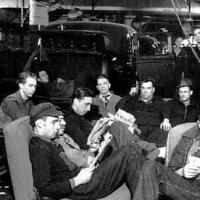This article was originally written for socialistworld.net, the website of the Committee for a Workers’ International.
When workers shut down GM
This year marks the 75th anniversary of the 44-day GM sit-down strike. This organized the largest automaker in the world and established the United Auto Workers (UAW) as one of the most powerful unions in the U.S. The impressive gains they won in the 1930s led auto jobs to be seen as the symbol of good union jobs with high wages and solid benefits.
With mass unemployment returning, remembering how the UAW was originally built can help workers understand how they can organize against the bosses’ attacks and win today.
The Depression
Workers in the early 1930s faced brutal conditions. Union membership had been cut in half since 1920 as employers laid-off tens of thousands of workers and slashed the wages of those lucky enough to keep their jobs by 65%. Mass production workers (auto, steel, textiles, etc.) worked long hours for poverty wages with no benefits, had no control over their working conditions, and had no union to fight for their interests.
If a worker stuck his neck out to challenge an employer, he could be fired at will and easily replaced from the army of 16 million unemployed workers.
Workers not only had to fight against the bosses’ dictatorship in the factory, but they also had to organize around the existing union leaders. The American Federation of Labor (AFL) was the only labor federation at the time. Their failed policy of craft unionism divided workers into multiple unions based on job classification, each with a separate contract with the employer even if they worked side by side on the same assembly line.
The AFL was proving unable to defend the gains of the past let alone organize new workers. Craft unionism was a strategy of “organizing for permanent disorganization” as workers were conditioned to look after their own sectional interests, and locals selfishly competed over dues-paying members.
Despite the obstacles, rank and file workers in the auto plants were fighting back. At their head were Communists, Socialists, and other class-conscious militants who understood that the power of the workers in the auto plants lay in their ability to organize as a class. They fought for industrial unions where all workers in a factory were organized side by side into the same union regardless of job classification.
In many auto plants the rank and file organized new federated locals as a way to maneuver around the craft unions. These were industrially organized locals that presented their existence to the AFL as an accomplished fact, and affiliated directly to the federation’s executive to prevent being split up among rival craft unions. The AFL leadership was willing to recognize the federated locals for a time, though they saw them primarily as holding tanks of workers to be divided later.
Fighting Back
As the initial shock of the Depression wore off, auto workers began to reverse the tide. The election of Franklin D. Roosevelt and the passage of the National Recovery Act in 1933, with its article 7a supposedly giving workers the right to organize, boosted their struggle. While article 7a didn’t actually give workers anything they hadn’t had before, it had a substantial psychological effect that increased workers’ confidence, and a wave of strikes spread across the nation’s auto plants.
Despite the courageous efforts of the auto workers, most of these strikes ended in defeat. The courts issued employer-friendly injunctions against pickets set up by strikers, while the police and National Guard escorted scabs into the factories to keep the bosses’ profits flowing. Without stopping the scabs, the auto workers had no leverage.
But in 1934, auto workers in Toledo scored a victory in the class struggle that inspired workers nationwide.
The Toledo workers were led by socialists who defied the courts and stood up to the police and National Guard. They were determined to stop scabbing even if they had to break the law and fight the state to do it. Organizations of the unemployed were brought onto the side of the union and strengthened picket lines in defiance of court injunctions. By relying on their own organized strength, and though bitter struggle, they organized 19 auto plants in a series of strike victories.
The Struggle for the UAW
At the same time, worker activists across the country were agitating for an international auto union. This movement took shape around a series of rank and file conferences where delegates from auto plants nationwide gathered. The resolutions coming out of these conferences called for an international union along industrial lines, democratically controlled by the rank and file, as well as a detailed plan for a general strike of workers in the auto industry.
Finally under pressure from below, the AFL called the founding convention of the UAW in August 1935.
The position of rank and file activists in the UAW was strengthened when splits opened up in the AFL leadership over the question of industrial vs. craft unionism, and the Committee for Industrial Organization (CIO) was formed.
By this time the character of auto locals across the country had drastically changed from just a few years before. These locals had been tempered in the heat of brutal industrial battles, and more militant figures had been pushed into leadership positions. The locals that had survived the last period were those that had overcome every obstacle in their path including ruthless bosses, company spies, employer-friendly courts and police, and back-stabbing politicians and union bureaucrats.
By the end of 1935 auto locals were notching up victories one after another. Workers at a plant would democratically work out a series of demands and elect a strike committee representing the entire factory. They would present their demands to the bosses with a deadline, and if the demands weren’t met, they struck with determination and militancy. Many victories were won in this manner.
In May 1936 the UAW held its second convention. Democratically elected leaders replaced the old guard bureaucrats, and the convention adopted a progressive platform including a call for a national labor party and no discrimination against women, blacks, or communists.
A month later the UAW joined the new industrial union federation, the CIO, and was the most democratic, rank and file-controlled union in the country. Auto workers were ready to take on the industry giants, and GM was their first target. They wasted no time.
Sit-Down!
In 1936 workers developed a powerful new tactic in their battles against the bosses: the sit-down strike. Instead of massing pickets outside factories and fighting to keep scabs out, sit-downers occupied the plant itself, defended it like a fortress, and made certain the bosses wouldn’t make a dime until their demands were met. The tactic proved decisive.
In November 1936 workers at Fisher #1 in Flint, Michigan spontaneously sat down over speedups. Next Fisher Body workers in Atlanta and Kansas City sat down to defend co-workers who were fired for wearing union buttons. In December, fed up with stalling, 7,000 workers at Cleveland’s Fisher Body struck with 1,000 sitting down in the plant. They demanded a national contract with GM.
In the following days the sit-down spread to Fisher #1 and #2 in Flint after workers saw crucial dies being transferred out of the plants as the bosses tried to lessen the impact a strike would have. Within three weeks 15 other GM plants were shut down. These strikes were completely rank and file led with no pre-approval from the UAW leadership.
In January, the UAW officially recognized the strike and presented 8 demands to GM including union recognition with a closed shop (meaning all workers at the factory would be in the union), a 30-hour work week and 6-hour day, union control of production line rates, and the reinstatement of all fired unionists.
GM’s counter attack began with court injunctions ordering strikers out of the plants, which the strikers defied. Next came attempts to freeze and starve out the strikers by turning off the heat to the plants (this was Flint in January) and forming barricades through which food could not be passed.
But women organized into the Women’s Emergency Brigade and other workers on the outside successfully broke through police lines bringing food to the sit-downers. The police tried to retake the plants with teargas and guns but were repelled as workers hurled heavy bolts at them and blasted them with fire hoses.
As the strike dragged on, pressure was mounting on the strikers. New injunctions were issued against the sit-downers, and FDR openly talked about calling in the National Guard to break the strike.
Decisive action needed to be taken, so the strike organizers decided to spread the battle and attempt to occupy Chevy #4 which was a key engine producer for GM. The plan was carried out with military precision which involved a decoy occupation of Chevy #9 and even the deception of most of the strike committee to foil company spies!
The plan was an absolute success and GM folded, signing a contract with the UAW on February 11 giving them full recognition and reinstating all fired unionists. The victory ignited an explosion of sit-downs across many trades, with all workers looking to the UAW and the Flint sit-downers for assistance and inspiration. This led to a massive surge in unionization in industry after industry, as workers won real improvements in wages and working conditions.
The UAW conquered the seemingly invincible GM by showing the bosses who really has the power in society, the working class. By bringing the capitalists’ profits to a halt and relying on their own organized strength to stand up to all the forces allied against them, auto workers laid down a tradition of fighting unionism and workers’ power that we need to draw on today.

